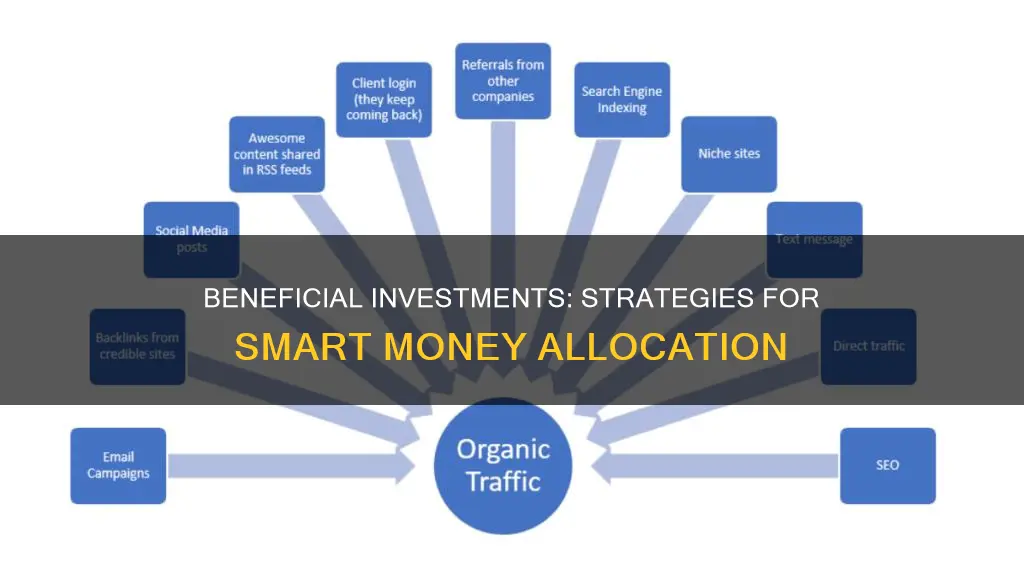
When it comes to investing, there are many options to consider, each with its own set of advantages and disadvantages. The best investment for an individual depends on their financial goals, risk tolerance, timeline, and other factors. While some investments carry more risk and offer higher potential returns, others are safer but may provide lower returns.
Some common investment options include high-yield savings accounts, certificates of deposit (CDs), bonds, mutual funds, index funds, exchange-traded funds (ETFs), stocks, and real estate. Each of these investments varies in terms of risk, liquidity, and potential returns.
It is important to understand the characteristics of each investment option and how they align with an individual's financial goals and risk tolerance. Diversification is also critical to maintaining a growing portfolio and mitigating the risks of losing all invested capital.
By considering factors such as financial goals, risk tolerance, investment budget, and potential for growth, individuals can make informed decisions about their investments and work towards achieving their financial objectives.
| Characteristics | Values |
|---|---|
| Risk tolerance | High-risk investments may offer higher returns but are more volatile. Lower-risk investments are safer but may not offer the same returns. |
| Time horizon | Investments with a long time horizon are better able to weather volatility and offer higher returns. Shorter time horizons require safer investments. |
| Knowledge | Requires research into the vehicles you are putting your money into. |
| Amount | The more money you can invest, the more likely it is that higher-risk, higher-return investments will be worthwhile. |
| Diversification | A broad range of investments can reduce portfolio risk. |
| Compounding | Investments that generate earnings or dividends which are then reinvested. |
| Liquidity | Some investments are less liquid than others and may be difficult to sell. |
| Tax implications | Understanding the cost of short-term and long-term capital gains tax rates. |
What You'll Learn

Risk tolerance and financial goals
When it comes to investing, it's important to consider your risk tolerance and financial goals. These factors will help you determine the types of investments that are most suitable for you. Here are some key points to keep in mind:
Understanding Risk Tolerance
Risk tolerance refers to how much risk you are comfortable taking on when investing. It's important to evaluate your comfort zone in taking on risk before making any investment decisions. All investments carry some level of risk, and it's crucial to understand that you could lose some or all of your money. The level of risk you are willing to take will depend on various factors, including your financial goals, time horizon, and personal financial situation.
Evaluating Financial Goals
It's essential to establish clear financial goals before investing. Are you investing for the short term or the long term? Do you have specific targets you want to achieve, such as saving for a down payment on a house or funding your retirement? Defining your financial goals will help guide your investment choices. For example, if you are saving for a long-term goal like retirement, you may need to include stocks or stock mutual funds in your portfolio to achieve the desired growth.
Matching Risk Tolerance with Financial Goals
Once you understand your risk tolerance and financial goals, you can start matching them to make informed investment decisions. For instance, if you have a low-risk tolerance and are saving for a short-term goal, you may consider investing in low-risk assets like savings accounts, certificates of deposit (CDs), or government bonds. On the other hand, if you have a higher risk tolerance and are investing for the long term, you might explore options like mutual funds, index funds, or stocks.
Diversification and Rebalancing
Diversifying your investments across different asset classes and industries can help reduce risk and smooth out investment returns over time. By investing in a variety of assets, you decrease the likelihood of losing all your money if one particular investment performs poorly. Additionally, rebalancing your portfolio occasionally is essential to maintaining your desired level of risk. This involves adjusting your portfolio back to your original asset allocation mix to ensure it aligns with your risk tolerance and financial goals.
Seeking Professional Guidance
If you are unsure about your risk tolerance or how to match it with your financial goals, consider consulting a financial adviser. They can provide guidance and help you access suitable investment opportunities based on your specific circumstances. Remember, investing involves risk, and there is no one-size-fits-all approach. It's crucial to carefully consider your own situation and seek professional advice when needed to make informed decisions.
Portfolio Investments: Balance of Payments Impact
You may want to see also

Diversification
By investing in multiple asset classes and across different industries and sectors, investors can lower the chances of losing all their capital. For example, if an investor's portfolio consists mostly of US-based companies, investing in foreign companies and various asset types can reduce the risk of significant losses if the US economy declines.
Overall, diversification is a powerful tool for investors to manage risk and achieve their financial goals. It allows investors to maintain a growing portfolio by ensuring they are not overly exposed to any one particular investment or market condition.
Trafigura's Investment Opportunities: Exploring Potential Avenues
You may want to see also

Long-term financial goals
- Risk and Return:
- Diversification:
Diversifying your investments across different asset classes, sectors, and industries is essential for long-term financial goals. By spreading your investments, you can reduce the risk of losing all your capital and smooth out investment returns over time. Diversification helps protect your portfolio from significant losses during market downturns and takes advantage of growth opportunities.
- Time Horizon:
- Research and Due Diligence:
Conducting thorough research before investing is vital for long-term financial goals. Understand the companies you are investing in, their business plans, financial health, and competitive advantages. Evaluate their historical performance, management decisions, and future prospects. Remember that past performance doesn't guarantee future results, but it can provide valuable insights.
Cost-Effective Options:
When investing for the long term, consider cost-effective investment options such as index funds or exchange-traded funds (ETFs). These investment vehicles offer diversification and tend to have lower fees than actively managed funds. They are excellent choices for long-term goals as they provide exposure to the market's overall performance and help keep costs down, maximizing your returns over time.
Regular Investment and Compounding:
Remember, investing for the long term requires a well-thought-out plan, discipline, and a long-term perspective. Consult with a financial professional to create a personalized investment strategy that aligns with your specific long-term financial goals.
Unlocking Private Equity: The Benefits of Listed Investments
You may want to see also

Investment types
There are many different types of investments, each with its own benefits and risks. Here are some of the most common investment types:
- High-yield savings accounts: These accounts offer higher interest rates than traditional savings accounts, making them a good option for those seeking a low-risk way to grow their money.
- Certificates of Deposit (CDs): CDs are federally insured savings accounts that offer a fixed interest rate for a defined period. They are a good option for those who want to lock in a guaranteed rate of return and don't need immediate access to their money.
- Bonds: Bonds are a form of fixed-income security, where investors lend money to a company or government entity in exchange for recurring interest payments. Government bonds are considered low-risk, while corporate bonds offer higher yields but come with more risk.
- Money market funds: These funds invest in high-quality, short-term government, bank, or corporate debt. They offer a slightly higher return than savings accounts but with a bit more market risk.
- Mutual funds: Mutual funds pool money from multiple investors to purchase a diverse range of stocks, bonds, or other assets. They are a convenient way for investors to diversify their portfolios and reduce risk.
- Index funds: A type of mutual fund that tracks a specific market index, such as the S&P 500. Index funds are passively managed and aim to match the performance of the underlying index.
- Exchange-traded funds (ETFs): ETFs are similar to mutual funds but are traded on stock exchanges, making them more flexible and accessible to investors. They offer diversification and lower fees than actively managed funds.
- Stocks: Stocks represent ownership in a company and can provide higher returns than other investments. However, they also come with higher risk and volatility.
- Dividend stocks: These are stocks that pay out regular cash dividends to shareholders, often associated with stable, profitable companies. Dividend stocks can provide both fixed income and the potential for capital gains.
- Real estate: Real estate investments involve purchasing physical properties or land, which can then be used for residential, commercial, or industrial purposes. Real estate can provide steady income through rent and potential capital appreciation over time.
- Commodities: Commodities are tangible investments such as gold, oil, or agricultural products. They can be a way to diversify a portfolio and hedge against inflation.
- Cryptocurrency: Cryptocurrency is a digital currency that has gained popularity in recent years. It is a highly volatile investment but can offer high returns.
- Collectibles: Collecting rare items such as sports memorabilia or art can be considered an investment if the items are expected to increase in value over time.
Each of these investment types comes with its own set of risks and potential rewards. It's important for investors to understand their financial goals, risk tolerance, and time horizon before deciding which investment types are most suitable for their needs. Diversification across different investment types can also help reduce risk and smooth out returns over time.
Rich People's Secrets: Unveiling Their Investment Strategies
You may want to see also

Market analysis
- Understanding Market Trends and Conditions: Stay informed about the current market trends and conditions. Study historical data, track economic indicators, and analyse industry-specific factors to identify potential investment opportunities and risks.
- Risk Assessment: Different investments carry varying levels of risk. Assess the risk associated with each investment option by considering factors such as market volatility, industry dynamics, and the financial health of the underlying assets. Diversification is a critical strategy to mitigate risk by spreading your investments across various assets, industries, and sectors.
- Performance Evaluation: Analyse the performance of potential investments over time. Look for consistent revenue and earnings growth, especially in different economic circumstances. This indicates the ability of an investment to withstand market fluctuations and increases the likelihood of long-term gains.
- Competitive Advantage: Identify companies or assets with a unique competitive advantage. This could be in the form of innovative products, strong brand recognition, or a solid business model that sets them apart from their competitors. A distinct advantage enhances the potential for sustained growth and higher returns.
- Financial Health: Evaluate the financial health of potential investments by examining factors such as debt levels, cash flow, and profitability. High debt levels relative to equity can be a red flag and impact a company's ability to grow.
- Income Generation: Consider investments that offer income-generating opportunities, such as dividend-paying stocks, rental properties, or interest-bearing bonds. These provide a steady source of passive income, contributing to the overall returns of your investment portfolio.
- Price Valuation: Be cautious of overpriced investments, as they may not offer favourable returns. Monitor market trends, investor behaviour, and price fluctuations to identify potential signs of investor exuberance or price manipulation.
- Sector and Industry Analysis: Diversify your investments across different sectors and industries to reduce risk. For example, investing solely in US-based companies may expose you to economic downturns in the US. By diversifying geographically and across sectors, you can lower the impact of negative events in any specific market or industry.
Building a Wine Investment Portfolio: A Beginner's Guide
You may want to see also
Frequently asked questions
Investing can provide you with another source of income, fund your retirement, or even get you out of a financial jam. It can also help your money outpace inflation and increase your purchasing power over time.
Before investing, it's important to evaluate your financial goals, risk tolerance, time horizon, knowledge of investing, and how much you can invest. You should also ensure you have an emergency fund and a manageable debt level.
Examples of good investments include high-yield savings accounts, certificates of deposit (CDs), government and corporate bonds, mutual funds, index funds, exchange-traded funds (ETFs), dividend-paying stocks, and real estate.
All investments carry some level of risk. To determine if an investment is worth the risk, consider its potential for growth, revenue and earnings growth, competitive advantage, debt levels, and ability to produce income. Diversifying your portfolio can also help reduce risk.
Saving involves accumulating money with no risk, while investing involves leveraging money for potential future gains with some risk. Saving is typically done for short-term goals, while investing is done for long-term goals like retirement.







